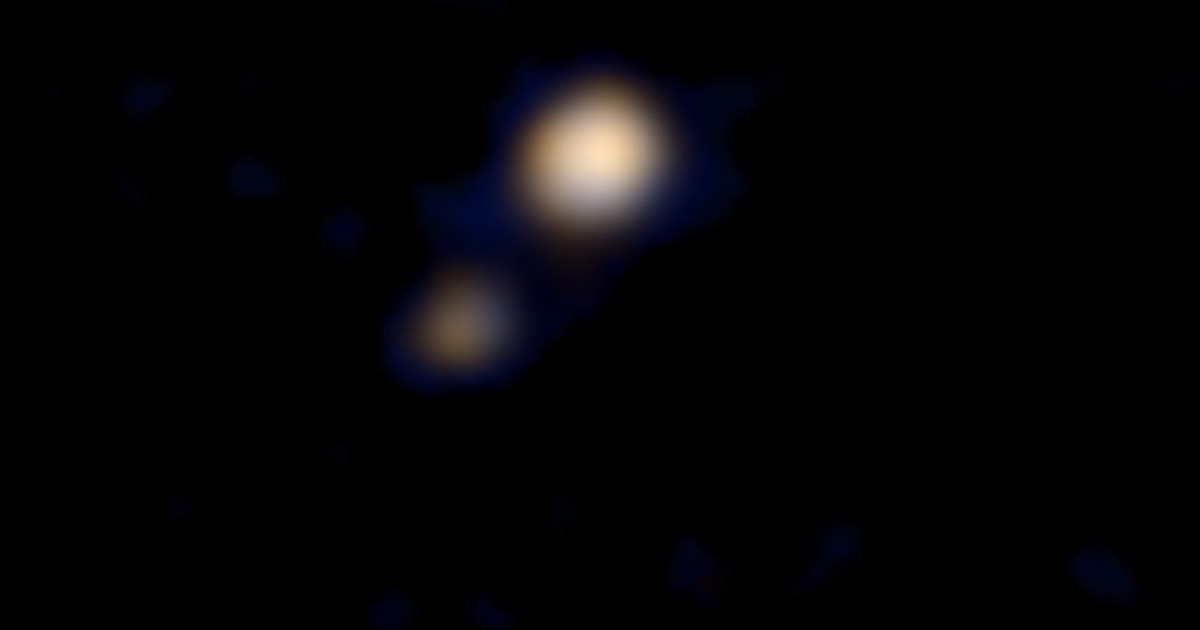NASA's New Horizons spacecraft has sent back its first full-color picture of Pluto and the dwarf planet's biggest moon, Charon — and although the image shows little more than a couple of dots, it hints at the unprecedented views to come.
The portrait released Tuesday was taken by the piano-sized probe's Ralph color imager on April 9, from a distance of about 71 million miles (115 million kilometers). "Starting in May, Pluto will get the highest-resolution images ever, and it's going to get better every day from there," said Cathy Olkin, a planetary scientist from the Southwest Research Institute who serves as deputy project scientist for the mission.
Image: Pluto and Charon
NASA / JHUAPL / SwRI
This image of Pluto and its largest moon, Charon, was taken by NASA's New Horizons spacecraft from a distance of 71 million miles. It is the first color image ever made of the Pluto system by a spacecraft on approach. The image is a preliminary reconstruction, which will be refined later by the New Horizons science team. At this distance, neither Pluto nor Charon is well resolved by the color imager, but distinct color differences can be seen.
July 14 will mark the mission's climax, when New Horizons zooms through the Pluto system at a speed of 30,000 mph (50,000 kilometers per hour). The pictures captured during that flyby will have a resolution as sharp as a quarter-mile (400 meters) per pixel — sharp enough to make out New York's Central Park if New Horizons were to fly by Earth instead.
The photo shoot will be so intense that no data will be transmitted back to Earth on that day, Olkin said. Instead, the New Horizons team will have to devote full attention to data acquisition. Starting the next day, billions of bits' worth of images and scientific data from the encounter will be sent by New Horizons' 12-watt transmitter over the course of 16 months, at a slow but steady rate of up to 1,000 bits per second.
John Grunsfeld, NASA's associate administrator for science, said New Horizons will "cap off our grand tour of the solar system" — a tour that has included close-up studies of worlds ranging from Mercury to Neptune.
Why Go to Pluto?
NBC News
Principal investigator Alan Stern said the mission would mark the first up-close look at a "binary planet" — that is, Pluto and Charon. It will also represent the first in-depth exploration of what Stern calls the solar system's "third zone," the ring of icy worlds that lie beyond the terrestrial planets and giant planets.
"Nothing like this is planned by any space agency ever again," Stern said. "This is a real moment in time, for you to watch us turn ... a point of light into a planet."
Stern and other scientists listed a string of potential discoveries that may lie ahead:
New moons to add to Pluto's known retinue of five, and perhaps rings of icy material as well.
Clues to the compositional differences between Pluto and Charon — which, like our own moon, is thought to have been formed out of the debris from a planetary crash.
Nearly global maps of Pluto and Charon, including permanently shadowed polar regions of Pluto that will have to be illuminated for New Horizons' cameras by Charon's reflected moonlight.
Liquid layers that may lie within Pluto and Charon, consisting of water or more exotic materials. "There could be rivers of neon that have been speculated about," Stern said.
First published April 14th 2015, 7:25 pm
The portrait released Tuesday was taken by the piano-sized probe's Ralph color imager on April 9, from a distance of about 71 million miles (115 million kilometers). "Starting in May, Pluto will get the highest-resolution images ever, and it's going to get better every day from there," said Cathy Olkin, a planetary scientist from the Southwest Research Institute who serves as deputy project scientist for the mission.
Image: Pluto and Charon
NASA / JHUAPL / SwRI
This image of Pluto and its largest moon, Charon, was taken by NASA's New Horizons spacecraft from a distance of 71 million miles. It is the first color image ever made of the Pluto system by a spacecraft on approach. The image is a preliminary reconstruction, which will be refined later by the New Horizons science team. At this distance, neither Pluto nor Charon is well resolved by the color imager, but distinct color differences can be seen.
July 14 will mark the mission's climax, when New Horizons zooms through the Pluto system at a speed of 30,000 mph (50,000 kilometers per hour). The pictures captured during that flyby will have a resolution as sharp as a quarter-mile (400 meters) per pixel — sharp enough to make out New York's Central Park if New Horizons were to fly by Earth instead.
The photo shoot will be so intense that no data will be transmitted back to Earth on that day, Olkin said. Instead, the New Horizons team will have to devote full attention to data acquisition. Starting the next day, billions of bits' worth of images and scientific data from the encounter will be sent by New Horizons' 12-watt transmitter over the course of 16 months, at a slow but steady rate of up to 1,000 bits per second.
John Grunsfeld, NASA's associate administrator for science, said New Horizons will "cap off our grand tour of the solar system" — a tour that has included close-up studies of worlds ranging from Mercury to Neptune.
Why Go to Pluto?
NBC News
Principal investigator Alan Stern said the mission would mark the first up-close look at a "binary planet" — that is, Pluto and Charon. It will also represent the first in-depth exploration of what Stern calls the solar system's "third zone," the ring of icy worlds that lie beyond the terrestrial planets and giant planets.
"Nothing like this is planned by any space agency ever again," Stern said. "This is a real moment in time, for you to watch us turn ... a point of light into a planet."
Stern and other scientists listed a string of potential discoveries that may lie ahead:
New moons to add to Pluto's known retinue of five, and perhaps rings of icy material as well.
Clues to the compositional differences between Pluto and Charon — which, like our own moon, is thought to have been formed out of the debris from a planetary crash.
Nearly global maps of Pluto and Charon, including permanently shadowed polar regions of Pluto that will have to be illuminated for New Horizons' cameras by Charon's reflected moonlight.
Liquid layers that may lie within Pluto and Charon, consisting of water or more exotic materials. "There could be rivers of neon that have been speculated about," Stern said.
First published April 14th 2015, 7:25 pm








Comment